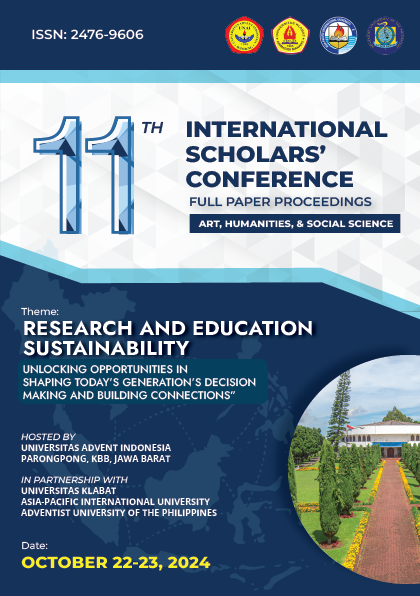Enhancing Farmers’ Resiliency through the Farmer’s Learning Center: A Qualitative Impact Assessment of Agricultural Interventions
Keywords:
agricultural interventions, on-farm research, roselle, qualitative impact assessment, food securityAbstract
Most impact assessments are done using a positivist’s approach, but interpretive designs provide rich insights from personal views of project recipients. Hence, a study was conducted to explore the impact of agricultural interventions of a university and their contribution toward farmer’s food security and increased income. This descriptive narrative research employed in-depth interviews among target participants following the guide questions formulated based on research objectives. Thematic analysis was used to bring about emerging codes, categories, and themes by using open, axial, and selective coding. The study generated six themes that serve as pieces of evidence on the impact of the extension project particularly the establishment of the Farmers' Learning Center (FLC), also known as the trial farm cum community seed bank, through bayanihan. A total of 23 different crops were grown in 2018 and planting materials were distributed to the farmers. Simultaneously, three indigenous crops namely foxtail millet, adlay and roselle were maintained in the FLC. The participants viewed FLC as a source of knowledge and at the same time they are treated as partners in development. Roselle which emerged as a resilient crop has therapeutic benefits and a potential source of income. The study highlighted the challenges encountered which include lack of market and participants’ limited technical knowledge in processing roselle. Thus, this study urges the university to continue the agricultural intervention to capacitate further the farmers and link them with agencies that offer equipment support to improve roselle processing, handling, packaging and storage.Downloads
References
Bandura, A. (2001). Social cognitive theory: An agentic perspective. Annual Review of Psychology. 52(1), 1-26.
Broadbent, C. (2022). “How to grow roselle from cutting.” Gardenia Organic. https:// gardeniaorganic.com/how-to-grow-roselle-from-cutting/
Cresswell, J.W. (2012). Educational research: Planning, conducting and evaluating quantitative and qualitative research. Pearson.
Climate Change Commission. (2011). National Climate Change Action Plan. Sistem Otot, 11(2), 1–21. http://eprints.uanl.mx/5481/1/1020149995.PDF
DeBord, K. (2007). How integrated extension programming helps market cooperative extension: the North Carolina recommendation. Journal of Extension, 45(5) http://www.joe.org/joe/2007october/comm1.ph.
Garbarino, S., & Holland, J. (2009). Quantitative and qualitative methods in impact evaluation and measuring results. https://gsdrc.org/publications/quantitative-and-qualitative-methods-in-impact-evaluation-and-measuring-results-3/
Gitz, V., Meybeck, A., Lipper, L., Young, C., & Braatz, S. (2016). Climate change and food security: Risks and responses. In Food and Agriculture Organization of the United Nations. https://doi.org/10.1080/14767058.2017.1347921
Gonzalez, C. 2011. Climate Change, Food security, and Agrobiodiversity: Toward a Just, Resilient, and Sustainable Food System. Fordham Environmental Law Review, Vol.22. Retrieved from http://ssrn.com/abstract=1756914.
IFAD (n.d.). Doing the right things and doing things right. https://www.ifad.org/en/impact-assessment
International Panel for Climate Change. (2022). Climate Change 2022 Impact, Adaptation and Vulnerability Summary for Policymakers.
Joyce, C. (2019). Plastic has a big carbon footprint-but that isn’t the whole story. https://www.npr.org/2019/07/09/735848489/plastic-has-a-big-carbon-footprint-but-that-isnt-the-whole-story
Maheswari, M., Sarkar, B., Vanaja, M., & ... (2019). Climate resilient crop varieties for sustainable food production under aberrant weather conditions. ICAR-Central Research …, (4). Retrieved from http://www.nicra-icar.in/nicrarevised/images/publications/Climate Resilient Crop_All Pages_12-03-19_low.pdf
Otto, I. (2020, May 28). Human development requires multidisciplinary engagement. https://council.science/current/blog/human-development-is-a-collective-striving-for-improvement-2/
Rogers, E.M. (2003). Diffusion of innovations (5th ed.). New York: Free Press.
Salingay, R., Aradilla, A., Molde, M.J., Lituanas, I. Valleser, J., Baldo, N., Paulican, M. S., Apiag, C. (2017). Terminal Report of the Enhancing Farmers’ Resiliency to Climate Change Effects through Community Actions and Adoption of Appropriate Technologies. Central Mindanao University.
Singh, P., Khan, M., & Hailemariam, H. (2017). Nutritional and health importance of Hibiscus sabdariffa: a review and indication for research needs. 6(5), 125–128. https://doi.org/10.15406/jnhfe.2017.06.00212
Wang, J. (2018). Integrating Indigenous with Scientific Knowledge for the Development of Sustainable Agriculture: Studies in Shaanxi Province. Asian Journal of Agriculture and Development, 15(2), 41–58.
Downloads
Published
How to Cite
Issue
Section
License
Copyright (c) 2024 11th International Scholars Conference

This work is licensed under a Creative Commons Attribution-ShareAlike 4.0 International License.
Copyright © 2024 ISC Committee.















